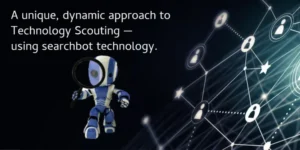If your organization is focused on adjacent, incremental or breakthrough technologies you will need a strong scouting team to get the work done. It all begins with budget planning and understanding your market. From there you can make the right decisions on the people, process and technology needed to succeed and ensure that the go to market is a success. In the Harvard Business Review article, Managing Your Innovation Portfolio, the data revealed that companies that allocated about 70% of their innovation activity to core initiatives, 20% to adjacent ones, and 10% to transformational ones outperformed their peers, typically realizing a P/E premium of 10% to 20%.
1. Hire a Dedicated Scouting Team: # of team members (2-5 people)

Building a scouting team requires a staff including a Product Manager/Portfolio Analyst, Innovation Manager, and a research team to perform the scouting functions needed to support the effort. We have researched these roles and salary commensurate with experience. The cost doesn’t end there. There is overhead needed to support the team’s work as well as ancillary costs including a workspace, supplies and benefits packages.
Let’s start with the Product Manager/Portfolio Analyst ($100,000 Year PLUS). Their role is to evaluate the current economic trends, historical performance, and future legislation that will impact the go to market likelihood of technology. Their role provides data-driven perspectives on the company’s innovation portfolio and pipeline. They provide project valuation, portfolio management process development and implementation as well as business case development for new adjacencies & technology acquisitions. Portfolio analyst commonly assists in the development of near-in and long-term category, brand, white space innovation and renovation strategies aligned with overall portfolio strategy. They recommend and develop new products that position the organization for future growth,
Next, you’ll need an Innovation Manager ($90,000 Year PLUS) – Their role within your company is to build relationships with Subject Matter Experts (SME) on developing trends and emerging technologies, that may be considered by and for its stakeholders. Communicating objectives and timelines is highly important to ensure timely completion of key projects. Innovation Managers also provide a level of continuity and support as product management responsibilities transfer post-market-launch including product enhancements and optimizations as needed.
In addition to the analyst and manager, you’ll need Research Associates (Level 1: $50,000 Year PLUS, Level 2: $62,000 Year PLUS, Level 3: $77,000 Year PLUS). The type of research will influence the number of associates and the skill level needed to accomplish the tasks.
A Research Associate is responsible for gathering data and building dynamic networks. They conduct research in specific areas and write technical reports detailing procedures, outcomes, and observations. They help the innovation manager build relationships with subject matter experts. They utilize established mathematical and scientific techniques to compile and analyze KPI goals and ROI measures.
As you can see there is a lot that goes into building a technology scouting team even before you reap the benefits of any internal scouting efforts.
2. Standardized Scouting Process Procedures
Once you have a team in place you will want to create an innovative culture. In addition, you will need a standardized process to follow that will ensure a successful deliverable focused on accomplishing the objectives of your organization. This begins with identifying the problem you want to solve, hence the portfolio analyst. They will assist with your innovation objectives by identifying the focus within your problem areas. As soon as you have a goal it is time to identify where the solution will come from, meaning is it through acquiring a startup, working directly with a subject matter expert, or maybe a university or research lab. Now that you understand your problem and have identified possible solutions to solve for it, you will need to establish the solution criteria. This includes but is not limited to funding, technology readiness level, markets, and sources. Depending on your internal resources it might be prudent to bring on a subject matter expert to work directly on the project and provide insight beyond research-level associates and your innovation manager capabilities.
At this point, it is time to data-mine the solutions. The tools will depend on the depth and complexity of the problem, the solution and the criteria need to solve it. There are tools specific to identifying startups. There are tools specific to identifying patents and there are tools specific to grant research. You might only need a single tool because your focus is very granular to a specific solution however there are also tools that encompass a multitude of data sets that will give you a clearer picture of adjacent, incremental or breakthrough technologies.
After the data mining is complete you move to validate the solutions. This is where it is helpful to have a subject matter expert who can help comb through the results and make educated recommendations based on the data analytics including source distribution, topic trends, commercial readiness and the main hubs throughout the world. Once the solution has been verified you can consider engaging in potential partnerships.
A successful scouting process would conclude with an executive summary and issuing NDAs to move forward. Whatever your process it is important to create standards, hold your team accountable and build your deliverables.
3. Technology Scouting Research Tools for Discovery and Research
Google is an amazing search engine, but it is only one of the tools available for performing internet research. Today’s tools go beyond google advanced searches to find the needle in the haystack. There are technology scouting tools that use sophisticated searchbot and artificial intelligence technology to crawl the digital universe and search every corner to find the latest in emerging disruptive technology and innovators. They identify specific keywords, traits and attributes, to locate relevant information, including technology and problems solvers.
It is integral to use a modernized approach to technology scouting while going far beyond the typical, legacy scouting approach with scouting automation.
The biggest challenge in this arena is filtering out the noise and categorizing the data discovery however technology scouting tools will allow a researcher to filter as granular as grants, patents, publications/scientific journals, trademarks, news, web monitoring and conferences. When considering a tool, it is important to understand the data sets it pulls from as well as the number of sources. Can you imagine getting 40 million data sources in less than 30 seconds? It’s possible and available today!

An important Technology Landscaping solution helps businesses solve innovation pain points by functioning as:
- An identifier of emerging technology
- A startup incubator
- An innovation discovery device
- A disruptive technology identifier
- An automated vendor sourcing tool
- An SME and crowdsourcing discovery
- Data mining and machine learning technology
- & more
Using technology landscaping tools will provide you with a superior analysis of the competition. Technology strength indicators, small and large corporation filter and analysis, organization social graph and collaboration, deep analysis and access to all documented material, access to data insights with comparisons. You will also be able to add new topics, uncover competitor adjacent opportunities, and conduct affiliation comparisons.
Today’s leading scouting tools for enterprise customers start between $20,000 to $50,000 depending on configuration and customizations.
4. Collaboration Software Tool to Manage, Sustain, Engage and Analyze
Your technology scouting team will need a place to collaborate on the challenges they are working to solve. For collaboration to happen successfully the tool needs to be flexible and offer options. By utilizing collaboration software, you ensure transparency for IP risk free idea capture and evaluation. This also give you a place to manage subject matter experts, vendors and customers. You should look for software that gives you options for managing internal and external communities with flexibility around private and public.
Collaboration software provides a space for collaborating. We will call it a community. This is where it all begins. You should have the option to collaborate internally, externally or both. Whether or not it’s your initial goal it is helpful to have a tool that allows you to reach beyond your own internal network to vendors, partners subject matter experts and customers. The communities need controls that limit views and access, allow users to join, recommend and chat with members. In addition, having sub communities allows for even more controls when building your collaboration groups.
Within your communities you engage your members by presenting your challenges needing solutions. Once a challenge is created the members need a way to submit ideas to solve the challenge. The structure of a challenge should be flexible. From an open text box, just give us your idea, to a structured survey with stage gate capabilities – having options for how you represent your challenge will result in better engagement.
To have successful collaboration you need to have idea management, reporting and analytics. Once an idea has been submitted, the collaboration software should work automatically, sorting and rating each submission based on user input. Ideas should be sortable according to business category, brand, idea, submitter or any other objectives that are important to the company or a project. Once ideas are sorted, robust workflows can automatically score, assign and send auto alerts and notification. A dashboard displaying idea submissions categorically, ideas submitted, and submitter drill-down give the scouting team quick overview on the progress of each project. By relying on predetermined criteria and an automated scoring system, your team can bypass low scoring submissions and focus time and effort on developing the most promising ideas.
Today’s leading collaboration tools for enterprise customers start between $20,000 to $50,000 depending on configuration and customizations.
As you can see there is a lot that goes into building a successful scouting team. It requires people, process and technology. In addition, there is the financial commitment to the tools and technology needed to be successful.
Good luck with building your team.






